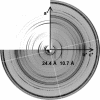Molecular basis for amyloid fibril formation and stability
- PMID: 15630094
- PMCID: PMC544296
- DOI: 10.1073/pnas.0406847102
Molecular basis for amyloid fibril formation and stability
Abstract
The molecular structure of the amyloid fibril has remained elusive because of the difficulty of growing well diffracting crystals. By using a sequence-designed polypeptide, we have produced crystals of an amyloid fiber. These crystals diffract to high resolution (1 A) by electron and x-ray diffraction, enabling us to determine a detailed structure for amyloid. The structure reveals that the polypeptides form fibrous crystals composed of antiparallel beta-sheets in a cross-beta arrangement, characteristic of all amyloid fibers, and allows us to determine the side-chain packing within an amyloid fiber. The antiparallel beta-sheets are zipped together by means of pi-bonding between adjacent phenylalanine rings and salt-bridges between charge pairs (glutamic acid-lysine), thus controlling and stabilizing the structure. These interactions are likely to be important in the formation and stability of other amyloid fibrils.
Figures




References
Publication types
MeSH terms
Substances
Associated data
- Actions
Grants and funding
LinkOut - more resources
Full Text Sources
Other Literature Sources
Research Materials
Miscellaneous

